We live in a world of imagery, and it’s never been more true than today. For most, the entire world’s existence is a sequence of images experienced by their minds’ eyes. We experience life visually. And while that’s been the case throughout human time, the number of images we experience has increased tenfold since the dawn of the digital age.
Our visual experiences are no longer limited to the world around us. We no longer rely on pictures in books to see the rest of the universe. Instead, we can access billions of images with the click of a mouse or a tap on a screen.

Digital technology has forever changed the way we experience images. Just 15 years after Netscape released the first commercially-available web browser in 1994, Flickr housed more than 6 billion photos – more than 450-times the total number cataloged by the Library of Congress. By 2009 so many amateur photographers were using camera-enabled devices – 2.5 billion, specifically – more photographs were captured in a single year than throughout the entire history of photography.
"This slurry of data signals the end of the Kodak Era where we took photos on birthdays and vacations and shared them only with a small group of friends," Bob Lisbonne, CEO of Luminate and former SVP for Netscape's browser group, said in 2012. "We've now entered a phase in which visual communication is supplanting the written word -- what some are calling the dawn of the 'imagesphere.'"
Visual storytelling has emerged as an important trend in web and graphic design, as well as other forms of marketing in the digital era – and for good reason. The visual cortex is the largest section of the human brain. According to a 2008 study, the average person remembers about 10 percent of what they hear when tested 72 hours later. But when visuals are added into the mix, the figure increases to 65 percent. It’s no wonder that publishers that feature infographics grow traffic 12-percent faster than those who don’t.
Now that marketers know how to successfully harness images to their communication efforts, visual stories are everywhere we look. Major publications such as The Wall Street Journal and The Atlantic have redesigned their web pages to prominently feature images and video. Emojis are truly everywhere we look, from text messages and Facebook posts to pillows and pajamas. New apps that allow users to communicate through images are emerging every day. The New The New York Times is even exploring the possibility of reporting stories through virtual reality.
Certainly such a drastic movement toward visual content isn’t coincidental, right? There’s got to be more to the change than pretty pictures. It’s true, there are plenty of reasons why visual storytelling is so successful, why digital marketers are relying so heavily on images – and here are the top 10:
1. The Visual Brain
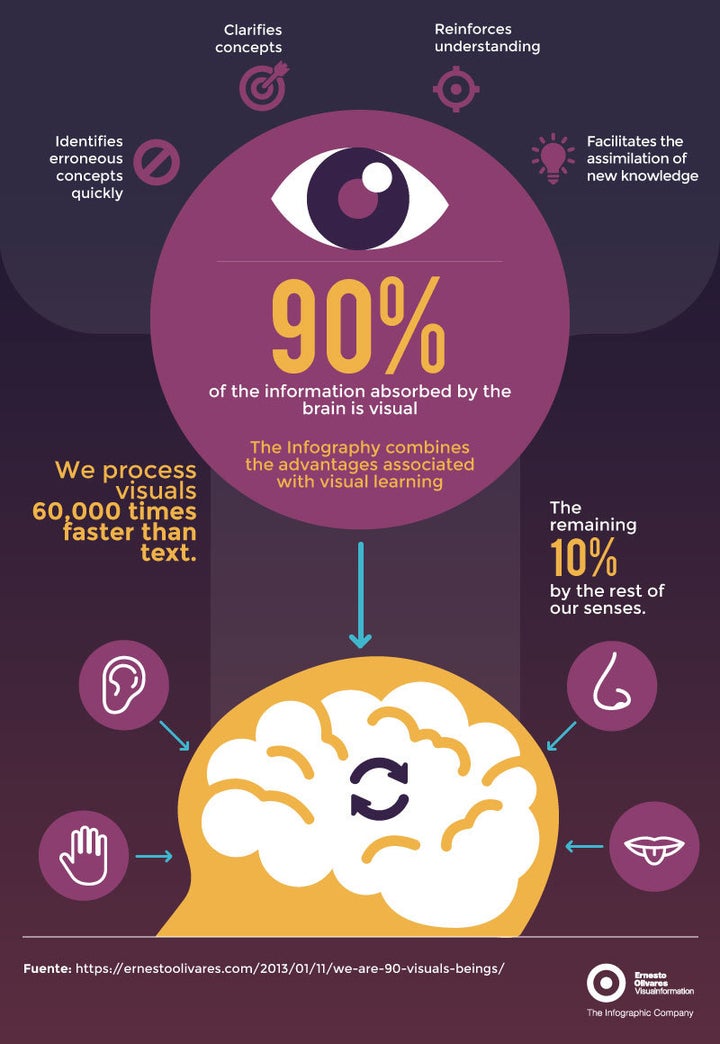
We’ve all heard that a picture is worth a thousand words, but that’s not exactly true. In fact, a single image can be worth so much more than even a thousand words can communicate. When presented correctly, images can communicate a complicated idea clearly and concisely in a way language could never convey.
“Modern day graphics can do much more than simply substitute for small statistical tables,” Edward Tufte, author of The Visual Display of Quantitative Information, wrote in 1983. “At their best, graphics are instruments for reasoning about quantitative information. Often the most effective way to describe, explore, and summarize a set of numbers…is to look at those numbers. Furthermore, of all methods for analyzing and communicating statistical information, well-designed data graphics are usually the simplest and at the same time the most powerful.”
Tufte knew what he was talking about. Countless studies indicate visual content’s superiority over text. 90 percent of all information transmitted to our brains is visual, and 93 percent of all communication is nonverbal. According to research at 3M Corporation, our brains can process visuals an astounding 60,000-times faster than text.
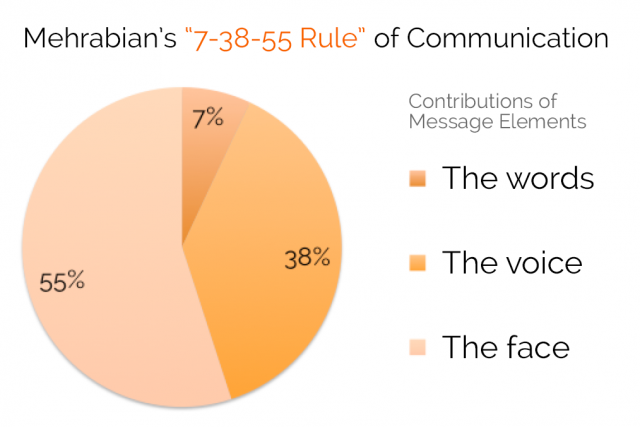
People are naturally attracted to images, which is obviously why content featuring relevant graphics gets 94 percent more views than content without, and tweets with images are retweeted 150-percent more often than those with only text. Images can be so powerful, they can even re-enforce concepts that aren’t necessarily true.
“Infographics and other images can be very powerful,” Pulitzer Prize-winning author Gareth Cook told Psychology Today. “For example, if you see the 50 states in red and blue, it’s easy to get the impression that each state is a monolith of Democratic or Republican thought. Americans are actually less polarized than that—much more purple.”
2. Audience Engagement
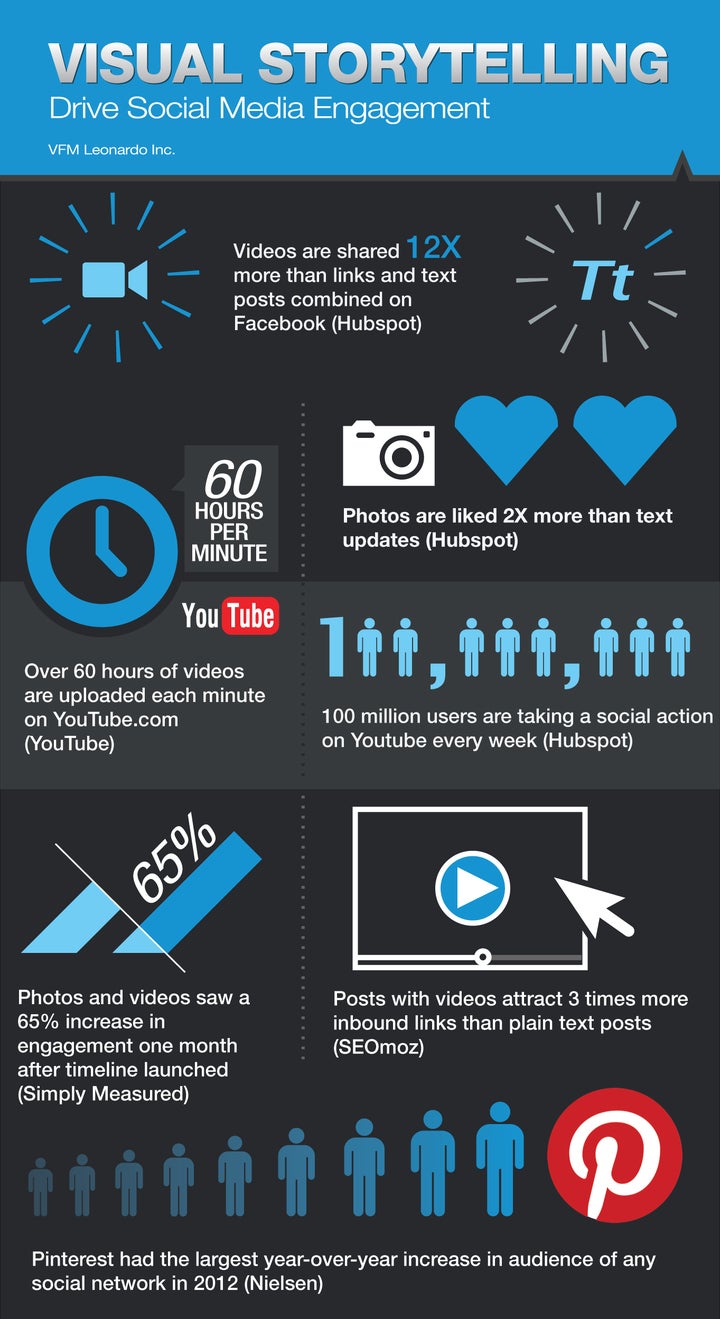
City dwellers 30 years ago saw about 2,000 marketing messages each day, according to market research firm Yankelovich. Today, that number has climbed to 5,000. It’s no wonder we are so overwhelmed with media. In fact, the average adult’s attention span has shrunk to a mere 8 seconds – shorter than a goldfish’s. Without engagement, audiences are quickly lost.
“Next to hunger and thirst, our most basic need is for storytelling.” – Khalil Gibran
In his research, Professor Allan Fels, Dean of the Australia and New Zealand School of Government, found that 70 percent of what we learn is consumed through storytelling. And while storytelling has always engaged audiences by stimulating imagination and emotion, visual storytelling takes the art a step further by fascinating our sense of sight and amplifying our response to the tale. An RIO Research Study found that respondents were 40 percent more likely to engage with brands if they post pictures.
The best visual stories capture audiences by:
- Teaching facts or provoking insight
- Helping or improving any aspect of life
- Entertaining with humor, action or suspense
- Spurring emotion
Social media presents additional opportunities for audiences to engage with visual stories: liking, sharing and commenting. According to a SocialBakers study, Facebook posts featuring photos see the most engagement, receiving 87 percent of total interactions. That engagement is the gift that keeps on giving, serving as free advertising as the content spreads from user to user across various social networks.
3. Maximum Creativity
We live in a society focused on numbers. Prices, quantities, dates statistics rule almost every facet of life. But let’s face it, numbers can be a tad dull. But dry and abstract numbers can be transformed into an engaging presentation that’s informative and persuasive with the strategic use of images, spacing and color.
“Modern day graphics can do much more than simply substitute for small statistical tables,” Tufte wrote. “At their best, graphics are instruments for reasoning about quantitative information. Often the most effective way to describe, explore, and summarize a set of numbers…is to look at those numbers.”
Visual storytelling allows digital marketers to forge a personal connection with audiences that just can’t be accomplished by text alone. And while creativity is key, it must be combined with strategy. Imagery creatively combined with either text or the spoken word takes storytelling to a new level by conveying emotion.

You’d be surprised what a splash of color can do. Psychology tells us that colors can influence emotion and affect action. Think about it: why are so many banks, hospitals and businesses are branded with green or blue? Subconsciously, blue creates a sense of trust and security, and green – the easiest color for our eyes to process – relaxes us and provides a sense of security.
Even the choice of font can influence audience reaction to content. While serif fonts have been found to convey authority, tradition and respect, sans-serif are considered clean, modern and stable. Finding the right balance between words and images can turn an ordinary message into a powerful impression.
4. Effective Calls to Action

Seeing is believing, and visual messages can motivate audiences to take action without ever asking them to do so.
Most internet users have long since tuned out the endless stream of spam, promotional texts and advertorials presented to them each day. Visual stories, on the other hand, can captivate audiences and influence their decisions without any verbal encouragement. Consider a glossy magazine ad for cosmetics or fashion: the campaigns rely on vivid product imagery that creates desire within potential customers. Never do they directly advise anyone to make a purchase. Do you think they’d be anywhere near as successful without the images?
5. Increased Authority

Again, seeing is believing. But depending on the audience, it might be for entirely different reasons. Before the internet, publishers had to spend a good deal of money to commission photos, graphics or video, and so their inclusion was generally noteworthy. Those living during that time – the Gen X and Baby Boomer audiences – still equate graphics with authority.
Likewise, their Millennial successors, who grew up on a digital world abounding with graphics, expect a visual element to any credible message. No images? Red flag! Something must be up with that story.
Because they leave little to the imagination, videos are generally considered the most authoritative sort of content. And they’re extremely effective. A Moz study found posts with videos got about 300 percent more backlinks. And EyeView found that including video content on landing pages increased conversion by 86 percent.
Of course in today’s online climate, authority accounts for much more than credibility. For years, Google has placed particular emphasis on authority level within its search algorithm. Those websites considered higher authorities will rank higher than others. How good a reference does a website make? One way the search engine interprets authority is by scanning a page for backlinks – and visual content attracts backlinks like a moth to a flame. In fact, according to Buzzsumo, infographics are shared more often than any other content type, including video.
6. Boosted Search Ranking
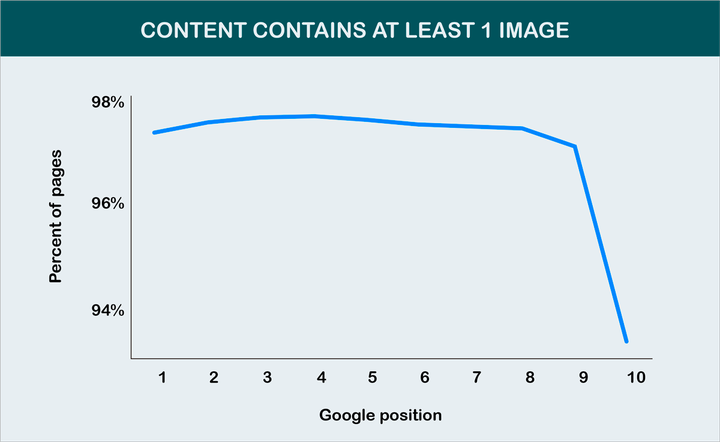
Internet marketing has been dominated by search engine optimization for more than a decade as experts have learned how to navigate the criteria and algorithms of various search engines to ensure their own or their client’s Web pages are ranked high in online search. It doesn’t matter how often Google, Bing and other search engines update their algorithms, quality content that naturally attracts visitors is still the name of the game. Websites that give users what they’re looking for will always be more popular, and more popular websites will almost always rank higher in search.
What web content is most attractive to 2017 Internet users? Without a doubt, it’s visual storytelling. According to MarketingSherpa, as much as 50 percent of website visitors determine whether to stick around on a web page within 8 seconds. That’s how quickly marketers must grab and hold their attention.
Since the human brain is hard-wired to absorb images it’s no wonder that visual storytelling has emerged as such a popular way to deliver a message. Did you know?
- Social media posts with visuals deliver 180 percent greater engagement.
- Articles containing images are viewed 94 percent more than those without.
- Blogs that integrate video attract 300 percent more inbound links.
- Video is 53 times more likely to generate a first-page Google ranking than other web content.
7. Higher Conversion
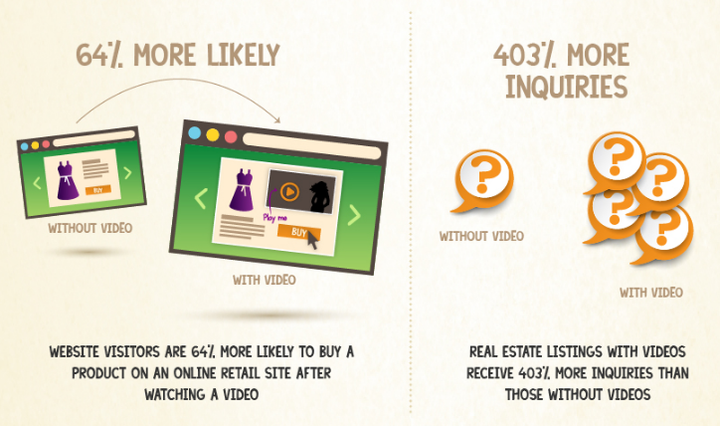
Engagement, authority, search rank: it all boils down to conversion. That is the entire purpose of marketing, after all. People like to see something before they buy. It’s hard to sell a product or a message with providing visual evidence. Simply put, content that features images converts to more sales.
In fact, videos on landing pages have actually shown to increase conversion rates by as much as 86 percent. Why? Perhaps visitors were too lazy to read the content, but were happy watching a video. Videos also increase the length of time visitors stay on a page, offering them more time to digest the message. And videos that feature people – employees and customers, for example – are considered more trustworthy.
8. Easier Design
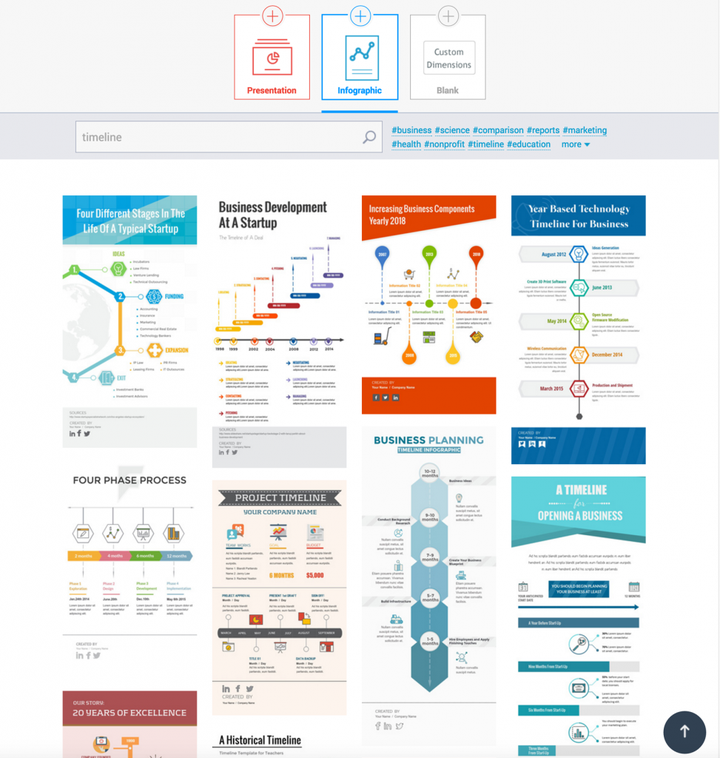
Visual designs and presentations used to require an experienced graphic artist or some savvy technical know-how, but no more. What was once a daunting task has become easier and more efficient thanks to a variety of online photo-editing tools. Visual storytelling has become more attainable for any digital marketer who utilizes free resources such as Visme, which helps users create amazing presentations, infographics and other amazing content.
“Visme made an immediate impact on our organizations data visualization and created more engaged conversations about internal programs and initiatives that were illustrated using the product,” Monumental Sports Entertainment marketing director Alex Kerr said.
So now you know that visual storytelling dominates digital marketing – and for good reason! So what are you waiting for?
